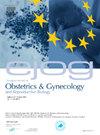Young surgeons’ perspectives on surgical anatomy teaching: Insights from a Delphi study
IF 2.1
4区 医学
Q2 OBSTETRICS & GYNECOLOGY
European journal of obstetrics, gynecology, and reproductive biology
Pub Date : 2025-03-17
DOI:10.1016/j.ejogrb.2025.03.039
引用次数: 0
Abstract
Objective
Minimally invasive surgery has gained popularity in gynecologic surgery over the last decades. With this, surgical training has inevitably changed, and new generations of surgeons have been faced with this paradigm shift. Current advances in technology, especially in minimally invasive surgery, as well as the rapidly changing surgical strategies pose a major challenge for the training of young surgeons. More focus on evolving technologies may result in a reduction in teaching hours and a possible decline in anatomy knowledge among medical professionals. The aim of this Delphi like survey was to explore the perspectives of young surgeons on surgical anatomy education and identify the most effective teaching tools and methods to enhance anatomical knowledge and surgical proficiency in the evolving landscape of gynecologic surgery.
Methods
A Delphi study was conducted during an international surgical anatomy meeting in Rome, involving 120 participants, including gynecologists, urologists, and general surgeons. An online, self-administered questionnaire consisting of 9 demographic questions and 48 general statements. Statements has been rated using a Likert scale (with 1 indicating strong disagreement and 9 strong agreement). Statements achieving ≥ 70 % consensus were excluded from subsequent rounds, while those with 60–70 % agreement were revised, reanalyzed and rephrased for the second round. The second-round questionnaire consisted of 7 revised statements, and the same procedure for analysis was applied. Data were analyzed using descriptive and inferential statistics. Statistical analyses were performed using SPSS v26, and results were summarized across two Delphi rounds.
Results
Consensus was achieved on several key areas of surgical anatomy education. Young surgeons agreed on Cadaveric models (88%) and virtual reality (VR) simulators (88%) as the most effective teaching tools, while plastinated specimens (41%) and anatomical drawings (46%) were deemed less effective. The necessity of standardized anatomical terminology was strongly endorsed (93%), as were foundational principles of open (98%) and vaginal surgery (90%). Participants emphasized the importance of hands-on training, with 91% supporting the need for practical skill development, including suturing and electrosurgical safety. A combined approach using virtual reality simulators and laparoscopic trainers was preferred (88%), while 78% of participants found cadaveric dissection and 3D models more effective than operating room observation. Additionally, 77% highlighted the importance of incorporating soft skills, such as leadership and teamwork, into surgical curricula. Despite advancements in teaching modalities, only 55% of participants reported being satisfied with the surgical anatomy education with 64% expressing the need for receiving more informations regarding techniques, instruments, costs, and materials.
Conclusions
This Delphi study underscores the importance of integrating traditional methods, such as cadaveric dissection, with innovative technologies like virtual reality simulators to create a multimodal approach to surgical anatomy education. Clear, standardized anatomical terminology is critical for enhancing learning and clinical practice. Addressing gaps in foundational knowledge, practical resources, and soft skills training is essential to improving surgical education. Future frameworks should balance theoretical, technological, and hands-on learning to equip young surgeons with the comprehensive skills required for modern surgical practice.
求助全文
约1分钟内获得全文
求助全文
来源期刊
CiteScore
4.60
自引率
3.80%
发文量
898
审稿时长
8.3 weeks
期刊介绍:
The European Journal of Obstetrics & Gynecology and Reproductive Biology is the leading general clinical journal covering the continent. It publishes peer reviewed original research articles, as well as a wide range of news, book reviews, biographical, historical and educational articles and a lively correspondence section. Fields covered include obstetrics, prenatal diagnosis, maternal-fetal medicine, perinatology, general gynecology, gynecologic oncology, uro-gynecology, reproductive medicine, infertility, reproductive endocrinology, sexual medicine and reproductive ethics. The European Journal of Obstetrics & Gynecology and Reproductive Biology provides a forum for scientific and clinical professional communication in obstetrics and gynecology throughout Europe and the world.

 求助内容:
求助内容: 应助结果提醒方式:
应助结果提醒方式:


